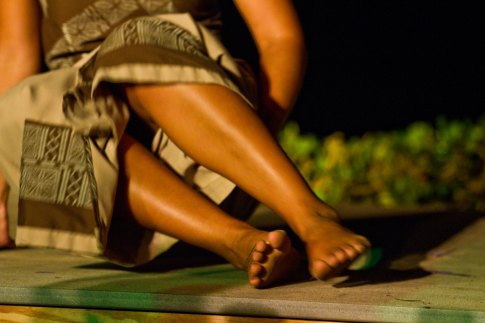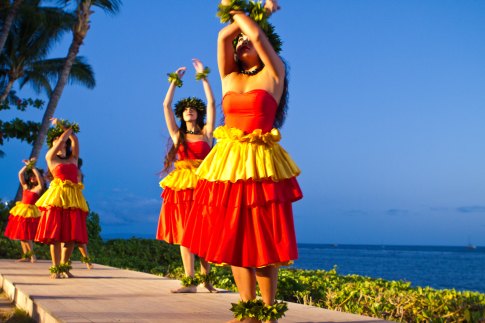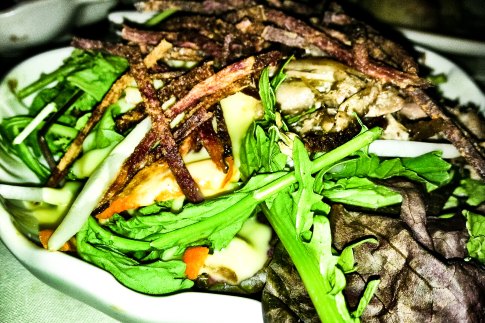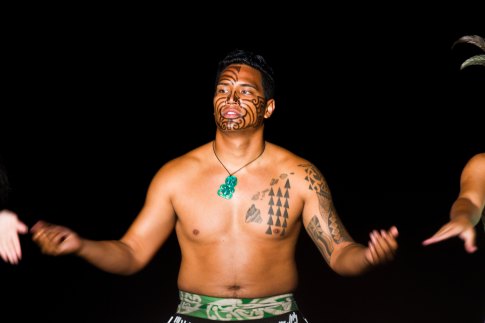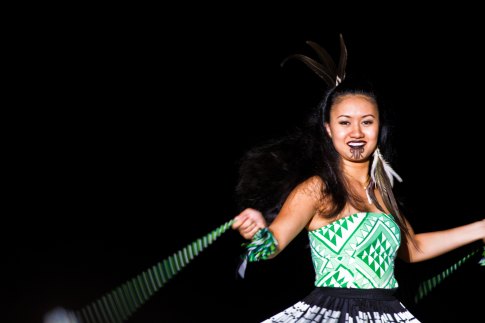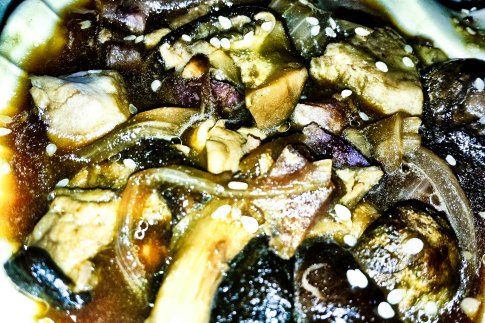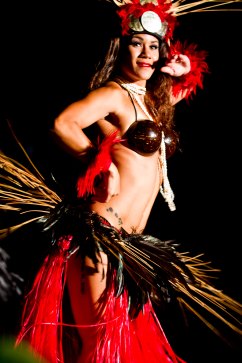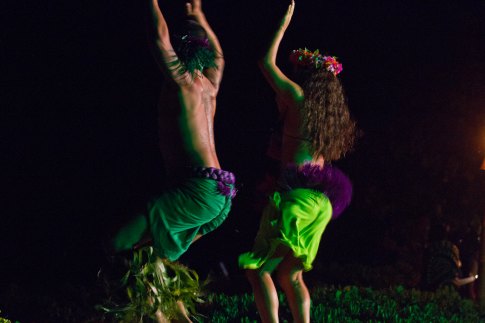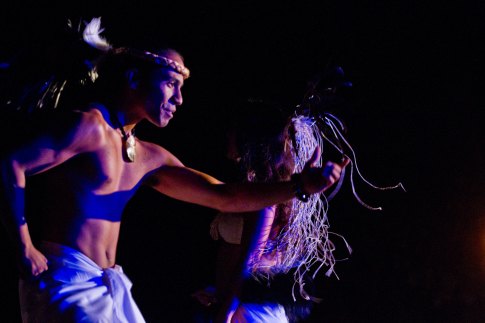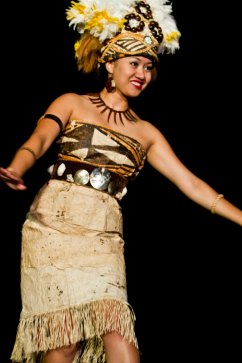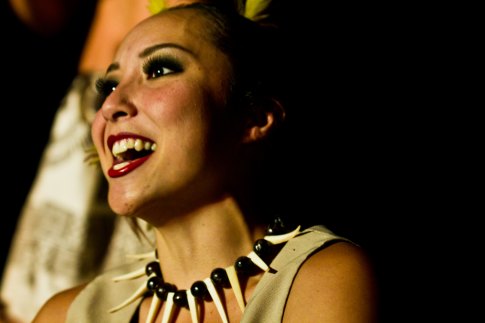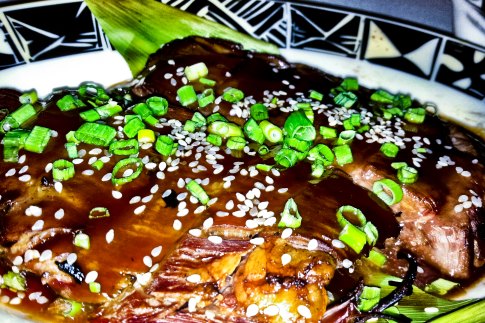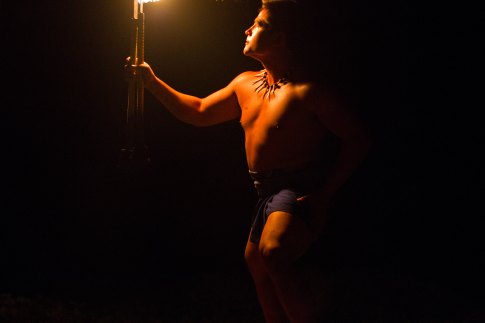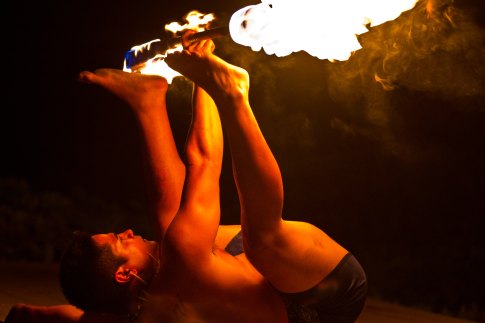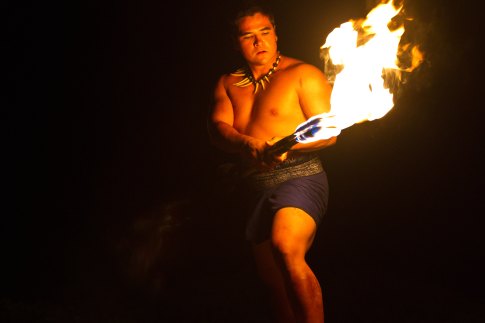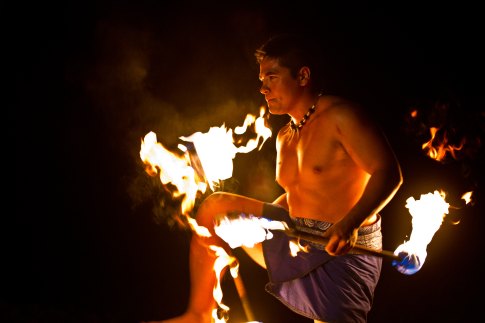Years ago I went to a more traditional Hawaiian luau on both Oahu and Kauai, but it had been awhile, before I started blogging and writing about culture. Any photographer who loves color and performance knows the excitement of shooting a great dance scene, particularly one rich with tradition and cultural roots, evident in their features and costumes they wear.
On my most recent trip, it seemed as if Luaus were not something people talked about or perhaps they just don’t hold as much importance as they once did. It could be that they’ve become so commercialized that what is more often shown to tourists is not as authentic anymore, so other purer things may have replaced it, such as a performance of women performing ancient hula in a smaller venue.
Great food combined with island music and dance – what a great tradition! The favorite dish at a historical luau feasts is what gave the Luau its name. Young and tender leaves of the taro plant were combined with chicken, baked in coconut milk and called luau.
The traditional Luau feast was eaten on the floor. Lauhala mats were rolled out and a beautiful centerpiece made of ti leaves, ferns and native flowers about three feet wide was laid the length of the mat. Bowls filled with poi, a staple of the Hawaiian diet made from pounded taro root, and platters of meat were set out and dry foods like sweet potatoes, salt, dried fish or meat covered in leaves were laid directly on the clean ti leaves.
Much to the consternation of the proper Victorian visitors, utensils were never used at a luau, instead everything was eaten with the fingers. Poi of various consistencies got its name from the number of fingers needed to eat it… three finger, two finger, or the thickest, one finger poi.
The one I attended years ago started with a fire pit, followed by moist banana stalks which were placed on top followed by a bed of banana leaves to put the pig on. The pig, sweet potatoes and laulau were placed in the imu and covered with more banana leaves and ti leaves.
While I realized that a lot of the ancient luau customs are not what they were, I was still eager to experience the Luau of 2012, especially since I love to cover music, culture, dance and performance. This trip, I learned about a less traditional kind of Luau in Lahaina, along the Maui coast. Coined the Feast at Lele, rather than focus on a fire pit, large tables that everyone shares or a big buffet that people wait in line for, they have gone in the opposite direction.
You reserve tables outside — on the beach — and courses are brought to your table, one-by-one, stage-by-stage, while you watch traditional dance performances. You can opt to sit with your family only or go as a larger group, but their sit down format tends to support a more private experience rather than a large party ambiance.
Feast at Lele also doesn’t only focus on Hawaii and the hula although Hawaii is where they start. The show takes you from Hawaii to New Zealand, Tahiti and ends in Samoa. It is a Polynesian journey that centers around the cultural traditions of each country, and as they make their way through the regions, the food changes to reflect the culture you’re watching at the time.
When the show starts, it is late afternoon and there is still some sunlight…
While you are watching the Hawaii portion of the show, they serve the first course which is a Kalua Pork, slow-roasted in an underground oven and shredded Pohole Fern Shoots and Hearts of Palm salad. You are also given a seared island fish, served with a mango sauce and tropical fruit salsa and green banana, sweet potato and taro chips served with a tropical ginger and seaweed salsa. All this is part of a four course meal.
The second dance comes from New Zealand and the Maoris. They are known for their elaborate art work, and their culture is rich in song and dance, intertwined with strong oratory skills. They wear facial tattoos or moko, which was used to symbolize ones genealogy and personal identity. Men performed the Kaha, a war dance that was used to intimate their enemies. Women performed a dance using poi balls, which are used to imitate the actions and rhythms in nature.
The course they served during the New Zealand portion of the performance was a sea bean duck salad with poha berry dressing, Kuku patties, fishcake with salmon, mussels and scallops served with a Manuka Honey Corn Relish. Then, there was a Harore Kumara, roasted mushrooms with orange sweet potato, onions and garlic. (yum).
Next came Tahiti, the land of intrigue and romance. The dance was more sensual, with strong swinging of the hips and pulsing rhythm of ancient drums. Oversized headdresses made of grasses and shells balanced the exuberant movements of hip and hand.
The main Tahiti dish was Fafa, steamed chicken and taro leaf in coconut milk. Secondly, E’iota, poisson cru or marinated fish and scallops on the shell.
The last course and performance is from Samoa, the “cradle of Polynesia” translated to the sacred center of its fiery soul. The dance is punctuated by staccato slapping of the legs and feet, and rhythmic clapping of hands. Men wear shredded leaf leggings which emphasize their movements, while women wear finely woven leaf-skirts to accentuate their gracefulness.
The last course was a Palusami breadfruit cooked with young taro leaf in a coconut cream sauce. It was followed by Supasui, grilled steak served with a soy, ginger and guava glaze, and Fresh Shrimp with avocado and papaya in a passion fruit dressing.
While you’re taking in the last of the tastes to come, fire enters the stage. The Samoan famed fire knife dance is an important component to their culture and since it’s so dramatic, it’s a very fitting end to the show.
For a list of where to go to experience a Luau on each of the islands, refer to the links below: (many of them are performed at the larger resorts and hotels)
For more posts on Hawaii, check out this section. For more on Hawaii and food/wine only, go here. For Hawaii and lodging, here.

Renee Blodgett is the founder of We Blog the World. The site combines the magic of an online culture and travel magazine with a global blog network and has contributors from every continent in the world. Having lived in 10 countries and explored over 90, she is an avid traveler, and a lover, observer and participant in cultural diversity. She is also the founder of the Magdalene Collection, a jewelry line dedicated to women’s unsung voices and stories, and the award-winning author of the bestselling book Magdalene’s Journey
She is founder of Blue Soul Media and co-founder of Blue Soul Earth as well as the producer and host of the award-winning Blue Soul CHATS podcast, that bridges science, technology and spirituality. Renee also founded Magic Sauce Media, a new media services consultancy focused on viral marketing, social media, branding, events and PR. For over 20 years, she has helped companies from 12 countries get traction in the market. Known for her global and organic approach to product and corporate launches, Renee practices what she pitches and as an active user of social media, she helps clients navigate digital waters from around the world. Renee has been blogging for over 16 years and regularly writes on her personal blog Down the Avenue, Huffington Post, BlogHer, We Blog the World and other sites. She was ranked #12 Social Media Influencer by Forbes Magazine and is listed as a new media influencer and game changer on various sites and books on the new media revolution. In 2013, she was listed as the 6th most influential woman in social media by Forbes Magazine on a Top 20 List.
Her passion for art, storytelling and photography led to the launch of Magic Sauce Photography, which is a visual extension of her writing, the result of which has led to producing six photo books: Galapagos Islands, London, South Africa, Rome, Urbanization and Ecuador.
Renee is also the co-founder of Traveling Geeks, an initiative that brings entrepreneurs, thought leaders, bloggers, creators, curators and influencers to other countries to share and learn from peers, governments, corporations, and the general public in order to educate, share, evaluate, and promote innovative technologies.

